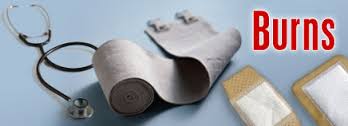Burns
Burns can be a life-threatening emergencies or minor medical problems. Many people die each year from fire-related burn injuries. Chemicals and also Electricity cause severe burns. Scalding liquids are the most common cause of burns in children.
Burns treatment depends upon the severity and location of the injury. Sunburns and small scalds can treat usually at homes. Widespread or Deep burns needs immediate medical attention.
People with severe burns need skin grafts to minimize scarring with deep wounds, or to cover large wounds emotional support and months of follow-up care, such as physical therapy.
Classifications of burns:
- First-degree burn: This minor burn affects only the epidermis (outer layer of the skin). It may cause swelling, redness, and pain. It usually heals with first-aid measures within a week.
- Second-degree burn: This type of burn affects both the dermis (the second layer of skin) and epidermis. It may cause pain, red, white or splotchy skin, and swelling and the wound looks moist or wet. Deep second-degree burns can cause scarring.
- Third-degree burn: These burns reach into beneath layer of the skin. Burned areas may be charred black or white. Due to this type of burns, skin looks leathery or waxy. These burns can destroy nerves and cause numbness in the body. People with this type of burn have experience smoke inhalation or difficulty in breathing or carbon monoxide poisoning.
Causes:
- Abuse
- Fire
- Hot liquid or steam
- Electrical currents
- Hot metal, glass or other objects
- ultraviolet light or sunlight from a tanning or bed sunlamp
- Radiation from X-rays or radiation therapy to treat cancer
- Chemicals such as strong acids, paint thinner or gasoline
Complications
- Low blood volume-Burns can damage blood vessels and cause fluid loss.
- Infection-
- Dangerously low body temperature
- Scarring: Burns can cause scars and ridged areas caused by an overgrowth of scar tissue.
- Breathing problems- lungs damage and respiratory failure.
- Bone and joint problems
Diagnosis:
- Physical exam: During this test the doctor examine the burned skin and percentage of total body surface area is involved.
- Lab tests, X-rays or other diagnostic procedures.
Treatment: Treatment of burns depends on the extent of the injuries. Minor burns may treat at homes by using aloe products or over-the-counter products. Burns usually heal within a few days to weeks.
For severe burns, after wound assessment and appropriate first aid care, treatment may involve wound dressings, therapy, medications and surgery. The goals of treatment are to control pain, prevent infection, remove dead tissue, reduce scarring, regain function and address emotional needs.
Medications and wound healing products for major burns:
- Water-based treatments: Care team use techniques such as ultrasound mist therapy to stimulate and clean the wound tissue.
- Fluids to prevent dehydration: Require IV (intravenous) fluids for the prevention of organ failure and dehydration.
- Pain and anxiety medications: Healing burns can be incredibly painful. Patient may need morphine and anti-anxiety medications particularly for dressing changes.
- Burn creams and ointments: Health care team can select from a variety of topical products for wound healing. This helps to reduce pain, keeps the wound moist, prevent infection and speed healing.
- Drugs that fight infection: If the infection may develop the patient need IV antibiotics.
- Dressings: Dressing may also be used to various specialty wounds. Dressing can create a moist environment to fights infection and helps the burn heal.
- Tetanus shot: Tetanus shot might recommend after a burn injury.
Occupational and Physical therapy: If the burned area is large, may need physical exercises therapy. These can help to stretch the skin so that the joints can remain flexible. Exercises can improve muscle coordination and strength.
Prevention
- Never leave items cooking on the stove unattended.
- Hot liquids Kept out of the reach of pets and children.
- Electrical appliances keep away from water.
- Don't heat a baby's bottle in the microwave.
- Unplug electrical devices when not in use.
- Readily keep a fire extinguisher on house.
